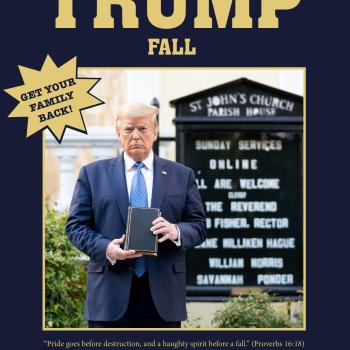
May is Asian Pacific American Heritage Month, and in a year when racism and violence against Asian Americans have captured public attention, more people are talking about the need to include Asian American perspectives in their school curriculum, course syllabi, and diversity, equity, and inclusion programming. I wholeheartedly support these efforts, and I’m genuinely excited that educators and researchers are paying more attention to Asian Americans in the fields of American history and American religion.
However, I must confess my concern that the well-intentioned effort to include more Asian American stories might still keep Asian Americans peripheral to the fundamental narrative of American religious history. An American religious history syllabus that remains centered on white, Protestant people of European descent is not much improved by tacking on a single class session dedicated to “Asian religions” at the very end. That’s not an inclusive syllabus—that’s an insulting and tokenizing syllabus that fails to engage in the excellent research on Asian American religious life.
To make an meaningful effort to include Asian American people in the telling of America’s past requires entire frameworks to change. For the past two decades, that type of change has been afoot in other areas of historical scholarship—most notably, in the subfield of U.S. immigration history. For example, because of Mae Ngai’s scholarship on Asian migration and immigration restriction in the early twentieth century, we think differently about the history of citizenship and “illegal aliens.” Because of Erika Lee’s research on Chinese exclusion, we have a deeper understanding of the origins of the bureaucratic apparatus for immigration detention and deportation. Because of Ellen Wu’s work on Asian Americans during the Cold War, we connect the history of immigration with the history of war. And because of Catherine Ceniza Choy’s history of Filipino nurses, we know how empire has shaped patterns and experiences of migration.
The same shifts need to happen in the study of American religious history. We don’t need the same story, the same setting, and the same plot, with a couple Asian American sidekick characters mixed in for color and comic relief. Rather, we, as a field, need serious engagement in Asian American experiences. Moreover, we need to be open to the fact that Asian American perspectives challenge how we have long researched and written about American religion. These challenges may unsettle those who insist on centering the history of American religious life on English Puritans and evangelical pastors. But they are also necessary and important if we, as a community of scholars, are committed to a richer and more complex understanding of American religious life in both the past and the present.
How does studying Asian American religion change how we how understand American religion? I argue that Asian American perspectives call into question three fundamental elements of the established narrative of American religious history: who the characters are, where the story unfolds, and what we mean by the thing that we call “religion.”

A different cast of characters
Studying Asian American religion first requires scholars to study Asian American people, and that means centering the story on a more religiously, racially, and ethnically diverse cast of characters. And when one does so, it becomes clear that America has always been much more than a tri-faith nation of Protestants, Catholics, and Jews.
According to the Pew Research Center, Asian Americans are the most religiously diverse racial group in the United States, and it’s because of increased migration from Asia over the past half century that America is now home to substantial populations of Hindus, Muslims, Buddhists, Sikhs, Jains, and practitioners of Asian spiritual traditions. Precise numbers are hard to come by, but estimates of religious adherents over the past half-century illustrate that the religious demographics of American society have changed significantly. In 1964, approximately 38,000 Muslims, 29,000 Hindus, and 171,000 Buddhists lived in the entire North American continent. Five years after the passage of the Hart-Celler Act, the United States was home to much larger numbers: 800,000 Muslims, 100,000 Hindus, and 200,000 Buddhists. And by the start of the twenty-first century, the United States counted 4 million Muslims, 1 million Hindus, and 2 million Buddhists.
Although the growth in the non-Christian population has accelerated in the past five decades, the presence of these religious communities has a long history in the United States. Indeed, well before mid-century immigration reforms opened the door to increased migration from Asia, there were already established Asian American religious communities throughout the country. Chinese immigrants established the first Buddhist temple in the United States in San Francisco in 1853, and Sikhs built the first gurdwara in the United States in nearby Stockton in 1912.
A large percentage of Asian Americans identify as Christian, and they, too, have had an important impact on American religious life. In a phenomenon that Stephen Warner describes as the “de-Europeanization of American Christianity,” Vietnamese and Filipino American Catholics have changed the demographics of parishes across the nation. (Even Saturday Night Live acknowledges that “little Filipino ladies” own the church.) At the same time, Korean and Chinese Americans have transformed evangelical and mainline churches, changing American religious life at the level of local congregations. They also wield significant influence at the national level, as evidenced by the fact that the current president of the National Association of Evangelicals, Walter Kim, is Korean American.
Like their Buddhist, Sikh, and Hindu counterparts, Asian American Christians have been present in the United States for a long time. In the nineteenth and early twentieth century, many Asian Americans identified as Christian and were active in church life. Christianity was central to how they formed communities, pursued dreams of prosperity and freedom, and insisted on fair treatment in the face of social, economic, and political injustice.
A different setting
Immigrants comprise a significant population within Asian America, and for this reason, Asian American communities must be understood as transnational communities whose intercontinental connections are maintained through a variety of means—remittances, retweets, recipes, and, yes, also religion. Indeed, religious beliefs, practices, networks, identities, and institutions are an important dimension of the transpacific diasporic experience. Here, then, is a second way that studying Asian American religion invites a new way of telling the broader story of American religion: it urges us to shift the setting away from the continental United States, broaden our geographic scope, and write about American religion with a more global framework. Put simply, Asian American religion illuminates the fact that American religion transcends national borders.
The transnationality of Asian American religious life became clear to me ni 2010, when my younger brother, a Naval officer, was deployed to Afghanistan. My devoutly Catholic parents enlisted a corps of Carmelite nuns at a convent in the Philippines to pray daily for his safe homecoming throughout the duration of his tour. I was intrigued by how prayer connected Filipinos at three locations around the world: a couple in Michigan, a community of nuns in Davao City, and a military officer in Bagram.
As I’ve written before, other Asian American communities have practiced transnational rituals, too. For example, in the 1970s and 1980s, isolated Hmong refugees resettled in the United States found it difficult to conduct healing and funeral rituals without relatives and ritual experts, and so they sought the help of Hmong people who remained in the refugee camps in Thailand. Using the postal service, Hmong refugees sent all the necessities—money, soil from burial sites, cassette tapes with descriptions of symptoms—to their friends and family overseas, and though the logistics of these transpacific rituals were complicated, they considered these adaptations to be necessary in the context of dire circumstances.
Asian American religion reveals how transnational religious institutions and networks have an impact not only on Asian and Asian American people, but also on non-Asian people. For example, in her forthcoming book, Sacred Allies: Cold War South Korea and the Rise of American Evangelicalism, Helen Kim argues that transpacific networks forged during the Korean War shaped the trajectory of modern American evangelicalism, especially through organizations such as World Vision, the Billy Graham Evangelistic Association, and Campus Crusade for Christ. Kim’s transpacific history of religious conservatism not only revises understandings of evangelicalism, but also invites scholars of American religion to consider a bigger question: how would our stories be different if we refused to be bound by national borders and instead chose to tell of America’s past as part of a global story?
A different approach to the theme of religion
Finally, Asian American religion poses important challenges to how we define and study religion. Scholars of American religion—like Americans in general—have historically defined religion on Western, Protestant terms: as something that’s belief-centered, private, centered on a text, guided by a clergy, and located in a congregation. But for many Asian American people, religion is less about belief and more about practice. It’s a set of rituals that take place in churches and temples, but also in seemingly secular spaces. It’s something that’s communal and public rather than individual and private. For some, there’s no official sacred text or formal leadership structure. And for still others, the word “religion”—the word, concept, and way of organizing their lives—is utterly foreign and not something they easily embrace as a description of their beliefs and practices, even if the legal, cultural, and political context of the United States pressures them to do so. In other words, Asian American religion challenges a Protestant-centric understanding of religion, thus unsettling the very theme that’s at the center of American religious history: religion.
The beliefs and practices of Chinese Americans offer a useful example of how Asian traditions confound the Western category of religion. That Chinese beliefs and practices are not commensurable to Protestant standards of religious life have meant that they are often overlooked and invisible to other Americans, including those who study religious life. For example, scholars have traditionally focused on congregations as sites of religious life. To be sure, Chinese Americans have continued to conduct many of their rituals at recognizably religious sites such as temples, monasteries, and meditation centers. At the same time, they’ve also made ritual offerings, erected altars, and celebrated religious festivals in homes, restaurants, stores, and city streets.
The incommensurability of Chinese traditions with the Western, Protestant-centric category of religion has meant that we’ve often overlooked the religiousness of Chinese American places and also the religiousness of Chinese American people. A 2012 Pew survey of Asian American religious life found that Asian Americans are the racial group with the largest percentage of religiously unaffiliated people. Among Asian Americans, Chinese American have the largest percentage of religiously unaffiliated people, with over half (52%) identified as religious nones. However, Kenneth Guest argues in God in Chinatown that social scientists have underestimated the religiosity of Chinese Americans because surveys have been shaped by an analytical framework that fails to reflect the spiritual lives of Chinese Americans adequately. Historically, Chinese beliefs and practices have centered on family and village customs that combine Buddhism, Daoism, and Chinese popular religious beliefs, and Chinese immigrants have continued to practice these intertwined traditions in the United States. For this reason, American religion survey questions that rely on a Western paradigm of religion are not appropriate for Chinese Americans. “Asking Chinese New Yorkers by telephone to place their religious beliefs within the framework of world religious systems such as Protestant Christianity, Catholicism, or Buddhism miscalculates the complexity and diversity of Chinese religious expression,” Guest says. “In this regard it should come as no surprise that the majority of respondents claim no religious affiliation.”
Aware of the limitations of the Protestant-centric definition of religion, scholars of Asian American religion have strived to find other ways to study the religious and spiritual lives of Chinese Americans. One strategy that Pew adopted in its 2012 survey of Asian Americans was to inquire not only about religious belief and identity, but about specific practices, such as whether respondents meditate, keep a home altar, or put up a Christmas tree. In addition, scholars have rejected the Western paradigm altogether and worked to develop an alternative framework that’s rooted in Chinese beliefs and practices. For example, in Family Sacrifices, Russell Jeung, Helen Kim, and Seanan Fong show that while Chinese Americans are the most non-religious group in the United States, they nevertheless hold deeply-held values and practice regular rituals, which they term “liyi.” Jeung, Kim, and Fong argue that, rather than understanding Chinese American religious nones in terms of the absence of religious affiliation, scholars must develop alternatives to the Western paradigm of religion. But what if developing alternative paradigms is something that not only scholars of Asian American religion do—what if all historians of American religion make a more concerted effort to approach the study of religion in new ways?
Over a decade and a half ago, when I was in my first year of graduate school at the University of Chicago, I took a life-changing seminar taught by Catherine Brekus. The seminar was on “the canon” of American religious history, and the syllabus included all of the great historical texts, from Robert Baird’s Religion in America to Sydney Ahlstrom’s A Religious History of the American People. I remember Ahlstrom’s book in particular because of it was the only book on my shelf that was larger than my copy of Joy of Cooking. At one point, I brought my copy of Ahlstrom’s book with me to the gym and wondered if I would have been better off staying home, where I could have done reps lifting the heavy book up and down by my desk and counting that as my strength training for the day.
I also remember looking in shock at the index and realizing that, amid the thousand pages of exhaustive historical detail, only a few paragraphs mentioned Asian Americans. The most fulsome paragraph included Ahlstrom’s declaration that, for Chinese and Japanese Americans, “since 1945 ethnic religious commitments have not figured prominently in their selfconsciousness as peoples.”
Both the country and the field of American religious history have changed significantly since 1972, when Ahlstrom published his volume, and we know better now. We now know that ethnic religious commitments were—and continue to be—very important for Chinese and Japanese Americans, as it is for other Asian Americans. And thanks to the hard work of generations of ethnic studies scholars, we now know that Asian American religious life has been more vibrant, developed, and significant than Ahlstrom acknowledged.
The reality, however, is that the Protestant-centered narrative that Ahlstrom told continues to shape much of the conversation about American religious history. And thus here is the crucial intervention that the study of Asian American religion can make: serious engagement in Asian American religious history invites an opportunity to reimagine American religious history overall.
And so, as we celebrate Asian Pacific American Heritage Month and begin to think ahead to our syllabi for the fall, I must issue this request. Please don’t include Asian American perspectives in your American religious history syllabus simply because you think that Asian Americans need to be part of the story. Rather, include Asian American perspectives in your syllabus because Asian American perspectives fundamentally change the story.

















